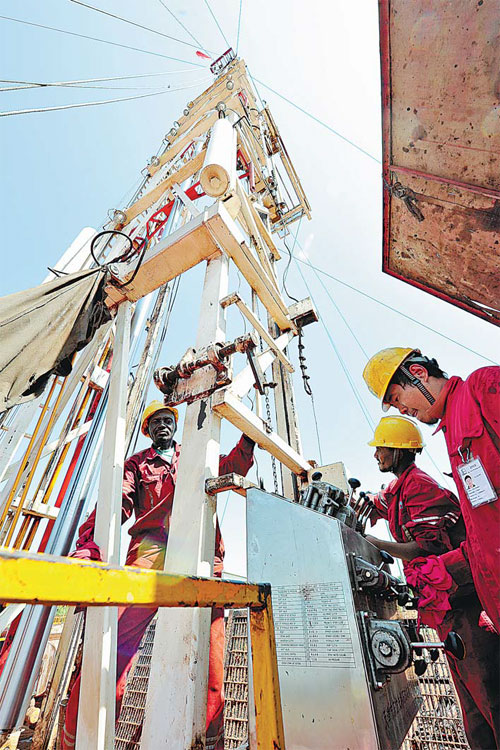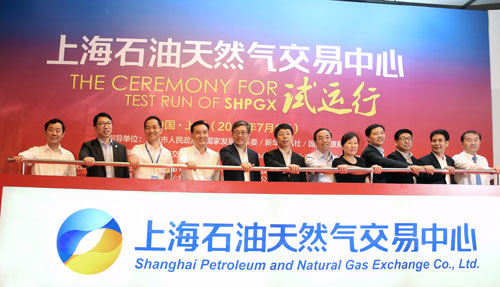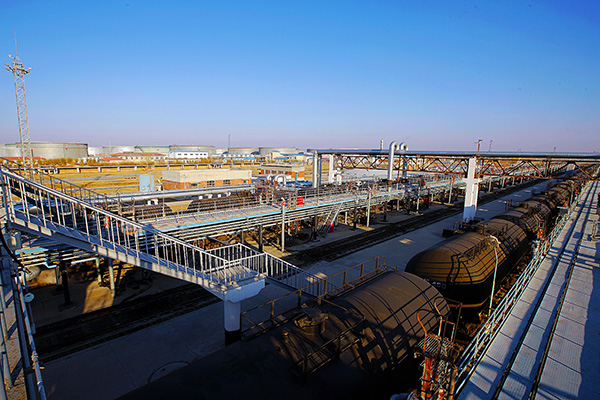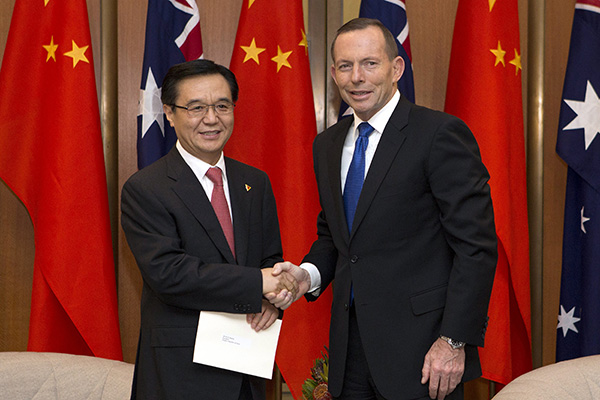Low oil prices gas up Chinese buyers
Source: www.chinamining.org Citation: China Daily Africa Date: June 19, 2015
As the downward trend levels out, companies from China are finding big bargains around the globe
A new wave of Chinese outbound oil acquisitions is expected in the second half of 2015 as well-financed Chinese firms take advantage of struggling companies while oil prices remain low globally, industry insiders say.
The huge drop in oil prices over the past year, from $110 per barrel in early July of last year to below $50 by the beginning of 2015, has fundamentally shocked the industry. But the prevailing forecast in the business is for price stabilization.

Chinese workers from Sinopec work with African colleagues at a facility in Sudan.
During this stabilization, a surge in global oil mergers and acquisitions is anticipated, with big implications for Chinese companies whose strong balance sheets and strategic investment mindset make them powerful buyers in the new environment.
"Since the middle of 2014, we`ve hardly seen any acquisitions by Chinese companies, but now that oil prices have stabilized, we would anticipate the pace of acquisitions to pick up," says Robin Matthews, managing director for Eurasia at Deloitte Upstream Oil & Gas Advisers.
Matthews says the previous lack of acquisitions was caused by the continuing drop in oil prices. The possibility always existed that after a bid was made, prices might soon drop even further.
Because oil prices are expected to remain in a new, lower price range, Chinese firms making acquisitions now can use a new scenario to evaluate their acquisitions, Matthews says.
In this new price environment, most oil companies are trying to cut costs by arranging better deals with their suppliers, negotiating 15-30 percent price cuts, while advanced deepwater rigs are going at day rates 50-60 percent lower than before, he says.
So Chinese firms should consider the efficiency of potential targets and evaluate the cost-return profile of oil fields requiring different extraction methods, he says. Chinese firms should especially consider how to maximize the synergy of their capabilities and the assets within their portfolios.
"In selecting good targets for acquisition, Chinese companies should probably look at assets that are big enough for them to be material and also fit well with the strengths of their portfolio," Matthews says.
That means Chinese companies should reassess their existing assets within the given portfolio and sell off "non-core assets" that may not be generating a desirable level of profitability or no longer be strategically important.
"Within a portfolio of assets a lot of synergy can be achieved if they are well managed. All large oil companies would have core and non-core assets and some assets become non-core over time as a firm`s strategy changes or the assets themselves change," Matthews says.
According to an analysis by Matthews` team, some of the assets held in Chinese firms` portfolios are already failing to achieve desirable profitability, but to date Chinese firms have not yet sold off any assets in their portfolio.
Chinese companies first ventured overseas for oil acquisitions in 1993, initially investing in oil and gas production in Thailand, Canada and Peru and, in 1995, in Sudan.
Chinese investments rapidly grew, and by 2014 Chinese national oil companies already operated in more than 40 countries, controlling about 7 percent of worldwide crude oil output. Between 2011 and 2014 alone, they spent total of $73 billion in outbound acquisitions, according to an International Energy Agency report.
The report also showed that Chinese national oil companies have combined overseas oil and gas production totaling 2.5 million barrels per day.
Most Chinese overseas investments are made in Africa, the Middle East and Eastern Europe, but CNOOC Ltd`s 2012 acquisition of Canada`s Nexen for $15.1 billion is noted as China`s biggest overseas acquisition.
This acquisition spree is partly due to China`s strong domestic demand for oil, but also reflects Chinese companies` desire to gain advanced extraction technology and oilfield operation expertise from industry leaders abroad. According to BMI Research data, Chinese crude oil production currently meets almost 40 percent of domestic crude oil demand.
Marina Petroleka, head of energy and infrastructure research at BMI Research, says that Chinese buyers have a steep learning curve on complex oil extraction techniques like offshore and Arctic oil extraction, but they can then use them in the domestic market or markets they can access easily.
Deep-water techniques could be helpful for Chinese firms that potentially wish to work in the deep-water environment of the South China Sea, while Arctic methodology could be helpful for Chinese firms eyeing an expansion to Russia, which is an area with oil resources that Chinese firms have good chances to access with the recent strengthening of relations between the two countries.
Last year, a consortium led by CNOOC, with a 60 percent stake, won a license to explore for hydrocarbons in the Icelandic Arctic, forming a partnership with two smaller firms in the project - Iceland`s Eykon and Norway`s Petoro.
Other areas Chinese firms may focus on include shale gas and shale oil and potentially methane hydrates. The latter is a relatively new source of which China is believed to have large offshore reserves. China is estimated to have the world`s largest shale gas resources. One of the reasons that CNOOC bought Nexen is that Nexen has technology in shale.
"Chinese companies want to be ahead of the curve. They want to partner up with Western firms in the international environment, and bring back technology and experience," Petroleka says.
Although Chinese firms have traditionally preferred full acquisitions, they should also consider minority stakes because many firms with oil assets in the exploration, production and development stages now want to sell their ownership given the new low price environment, Petroleka says.
"Internationally, many big firms are rationalizing their portfolios by focusing on certain areas and selling off assets in other areas, meaning there are many assets available and can be bought at cheaper prices," Petroleka says.
Those views are echoed by Jonathan Robinson, principal consultant of energy, environment and building technologies at Frost & Sullivan, who adds that Chinese investment in the North Sea is an example of their rapid learning in offshore extraction methods in a mature oil field, which could be used in their own aging oil fields in the future.
Robinson says offshore is more complex because it requires more advanced infrastructure and equipment, and demands more skilled engineers and complex oil extraction techniques like enhanced oil recovery.
"The North Sea would not be attractive for companies from a revenue or market share perspective, but it provides good access to competency. In the offshore oil sector, Chinese companies are still learning because traditionally they have more experience with oilfields on land."
CNOOC acquired a 43 percent stake in Buzzard, the UK`s largest producing oil field, located in the North Sea, as part of its 2012 Nexen acquisition. In the same year, Sinopec acquired a 49 percent stake in Canadian oil firm Talisman`s UK North Sea business.
In addition, the current Energy Bill proposed by the UK government suggests financial incentives for oil producers in the North Sea, as a way to support oil production in there. Robinson says these financial incentives could potentially make the North Sea more attractive for Chinese companies.
During the new wave of Chinese outbound oil acquisitions, companies also would be likely to search for opportunities in Latin American countries like Brazil and Argentina, Robinson says.
"Western firms may have been hesitant about some opportunities in these markets due to perceived risks. But because the Chinese government has good relationships with governments of many Latin American countries, Chinese firms may be more willing to invest in these countries, potentially by establishing joint ventures with local companies, which is the technique used by Chinese firms in Africa`s mining industry," he says.
Bjarne Schieldrop, chief analyst of commodities at SEB, the official name of the Swedish banking group Skandinaviska Enskilda Banken, adds that in the new low price environment where onshore oil production is generating good returns, Chinese firms could focus on helping countries in Latin America and Africa with underdeveloped onshore oil resources, which is consistent with China`s outbound resource acquisition strategy across all commodity sectors.
Also, consolidation within the US shale sector means potential acquisition opportunities exist for Chinese firms to buy US shale firms with good access to resources but too little cash to survive in the competitive environment, Schieldrop says.
About CHINA MINING
Since first held in 1999, the scope and influence of CHINA MINING has grown rapidly year by year. As a global mining summit forum and exhibition, CHINA MINING Congress and Expo has become one of the world’s top mining events, and one of the world’s largest mining exploration, development and trading platforms, covering all aspects of the whole mining industry chain, including geological survey, exploration and development, mining rights trading, mining investment and financing, smelting and processing, mining techniques and equipment, mining services, etc. playing an active promotion role in creating exchange opportunities and enhancing mutual cooperation between domestic and foreign mining enterprises.
CHINA MINING Congress and Expo 2015 will be held at Meijiang Convention and Exhibition Center in Tianjin on November 20th-23rd, 2015. We invite you to join the event and to celebrate the 17th anniversary of CHINA MINING with us. For more information about CHINA MINING 2015, please visit: m.balanzskin.com.







